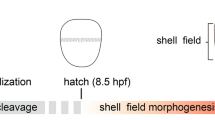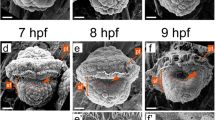Abstract
We examined dpp expression patterns in the pulmonate snail Lymnaea stagnalis and analyzed the functions of dpp using the Dpp signal inhibitor dorsomorphin in order to understand developmental mechanisms and evolution of shell formation in gastropods. The dpp gene is expressed in the right half of the circular area around the shell gland at the trochophore stage and at the right-hand side of the mantle at the veliger stage in the dextral snails. Two types of shell malformations were observed when the Dpp signals were inhibited by dorsomorphin. When the embryos were treated with dorsomorphin at the 2-cell and blastula stages before the shell gland is formed, the juvenile shells grew imperfectly and were not mineralized. On the other hand, when treated at the trochophore and veliger stage after the shell gland formation, juvenile shells grew to show a cone-like form rather than a normal coiled form. These results indicated that dpp plays important roles in the formation and coiling of the shell in this gastropod species.








Similar content being viewed by others
References
Ackerly S C (1989) Kinematics of accretionary shell growth, with examples from brachiopods and mollusks. Paleobiology 15:147–164
Bandel K (1990) Shell structure of the Gastropoda excluding Archaeogastropoda. In: Carter JG (ed) Skeletal biomineralization: patterns, processes and evolutionary trends. Van Nostrand Reinhold, New York, pp 117–133
Baratte S, Andouche A, Bonnaud L (2007) Engrailed in cephalopods: a key gene related to the emergence of morphological novelties. Dev Genes Evol 217:353–362
Bielefeld U, Becker W (1991) Embryonic development of the shell in Biomphalaria glabrata (Say). Int J Dev Biol 35:121–131
Cannon JE, Upton PD, Smith JC, Morrell NW (2010) Intersegmental vessel formation in zebrafish: requirement for VEGF but not BMP signalling revealed by selective and non-selective BMP antagonists. BJP 161:140–149
Cartwright JHE, Checa AG (2007) The dynamics of nacre self-assembly. J R Soc Interface 4:491–504
Chaikuad A, Alfano I, Shrestha B, Muniz JRC, Petrie K, Fedorov O, Phillips C, Bishop S, Mahajan P, Pike ACW, von Delft F, Muller-Knapp S, Lee WH, Marsden BD, Arrowsmith CH, Edwards AM, Weigelt J, Bountra CK, Knapp S, Bullock A, Structural Genomics Consortium (SGC) (2009) Crystal structure of the kinase domain of type I activin receptor (ACVR1) in complex with FKBP12 and dorsomorphin. RCSB PDB Protein Data Bank, Worldwide Protein Data Bank. http://www1.rcsb.org/pdb/explore.do?structureId=3H9R
Collin R, Voltzow J (1998) Initiation, calcification, and form of larval “archaeogastropod” shells. J Morphol 235:77–89
DePaula SM, Huila MFG, Araki K, Toma HE (2010) Confocal Raman and electronic microscopy studies on the topotactic conversion of calcium carbonate from Pomacea lineate shells into hydroxyapatite bioceramic materials in phosphate media. Micron 41:983–989
Eyster LS (1986) Shell inorganic composition and onset of shell mineralization during bivalve and gastropod embryogenesis. Biol Bull 170:211–231
Eyster LS, Morse MP (1984) Early shell formation during molluscan embryogenesis, with new studies on the Surf clam, Spisula solidissima. Am Zool 24:871–882
Fukura S, Mizukami T, Odake S, Kagi H (2006) Factors determining the stability, resolution, and precision of a conventional Raman spectrometer. Appl Spectrosc 60:946–950
Grande C, Patel NH (2009) Nodal signalling is involved in left–right asymmetry in snails. Nature 457:1007–1011
Hinman VF, O’Brien EK, Richards GS, Degnan BM (2003) Expression of anterior Hox genes during larval development of the gastropod Haliotis asinina. Evol Dev 5:508–521
Iijima M, Takeuchi T, Sarashina I, Endo K (2008) Expression patterns of engrailed and dpp in the gastropod Lymnaea stagnalis. Dev Genes Evol 218:237–251
Jacobs DK, Wray CG, Wedeen CJ, Kostiken R, Desalle R, Staton JL, Gates RD, Lindberg DR (2000) Molluscan engrailed expression, serial organization, and shell evolution. Evol Dev 2:340–347
Jardillier E, Rousseau M, Gendron-Badou A, Frohlich F, Smith DC, Martin M, Helleouet MN, Huchette S, Doumenc D, Auzoux-Bordenave S (2008) A morphological and structural study of the larval shell from the abalone Haliotis tuberculata. Mar Biol 154:735–744
Kin K, Kakoi S, Wada H (2009) Novel role for dpp in the shaping of bivalve shells revealed in a conserved molluscan developmental program. Dev Biol 329:152–166
Koop D, Richards GS, Wanninger A, Gunter HM, Degnan BM (2007) The role of MAPK signaling in patterning and establishing axial symmetry in the gastropod Haliotis asinina. Dev Biol 311:200–212
Kuroda R, Endo B, Abe M, Shimizu M (2009) Chiral blastomere arrangement dictates zygotic left–right asymmetry pathway in snails. Nature 462:790–794
Lambert JD, Nagy LM (2002) Asymmetric inheritance of centrosomally localized mRNAs during embryonic cleavages. Nature 420:682–686
Lowe LA, Yamada S, Kuehn MR (2001) Genetic dissection of nodal function in patterning the mouse embryo. Development 128:1831–1843
Meshcheryakov VN (1990) The common pond snail Lymnaea stagnalis. In: Dettlaff TA, Vassetzky SG (eds) Animal species for the developmental studies. Consultants Bureau, New York, pp 69–132
Morill JB (1982) Development of the pulmonate gastropod, “Lymnaea”. In: Harrison FW, Cowden RR (eds) Developmental biology of fresh water invertebrates. Alan R Liss, New York, pp 399–483
Moshel SM, Levine M, Collier JR (1998) Shell differentiation and engrailed expression in the Ilyanassa embryo. Dev Genes Evol 208:135–141
Nederbragt AJ, van Loon AE, Dictus WJ (2002) Expression of Patella vulgata orthologs of engrailed and dpp-BMP2/4 in adjacent domains during molluscan shell development suggests a conserved compartment boundary mechanism. Dev Biol 246:341–355
Okamoto T (1988) Analysis of heteromorphy ammonoids by differential geometry. Palaeontology 31:35–52
Raup DM (1966) Geometric analysis of shell coiling: general problems. J Paleontol 44:1178–1190
Rice SH (1998) The bio-geometry of mollusc shells. Paleobiology 24:133–149
Runnegar B (1996) Early evolution of the Mollusca: the fossil record. In: Taylor JD (ed) Origin and evolutionary radiation of the Mollusca. Oxford University Press, Oxford, pp 77–87
Savazzie E (1990) Biological aspects of theoretical shell morphology. Lethaia 23:195–212
Shigeno S, Sasaki T, Moritaki T, Kasugai T, Vecchione M, Agata K (2008) Evolution of the cephalopod head complex by assembly of multiple molluscan body parts: evidence from nautilus embryonic development. J Morphol 269:1–17
Stone JR (1995) CerioShell: a computer program designed to simulate variation in shell form. Paleobiology 21:509–519
Wanninger A, Haszprunar G (2001) The expression of an engrailed protein during embryonic shell formation of the tusk-shell, Antalis entalis (Mollusca, Scaphopoda). Evol Dev 3:312–321
Acknowledgments
We thank Prof. H Wada, Y Kurita (University of Tsukuba), Prof. K Matsuno, and J Kuroda (Tokyo University of Science) for discussion, suggestions, and help in functional analysis of dpp. We thank Prof. T Kogure, K Ichimura, and N Yoko (The University of Tokyo) for help with compositional analysis. This study was supported by the JSPS Grants-in-Aid for Scientific Research 15104009.
Author information
Authors and Affiliations
Corresponding author
Additional information
Communicated by D. Weisblat
Rights and permissions
About this article
Cite this article
Shimizu, K., Sarashina, I., Kagi, H. et al. Possible functions of Dpp in gastropod shell formation and shell coiling. Dev Genes Evol 221, 59–68 (2011). https://doi.org/10.1007/s00427-011-0358-4
Received:
Accepted:
Published:
Issue Date:
DOI: https://doi.org/10.1007/s00427-011-0358-4




